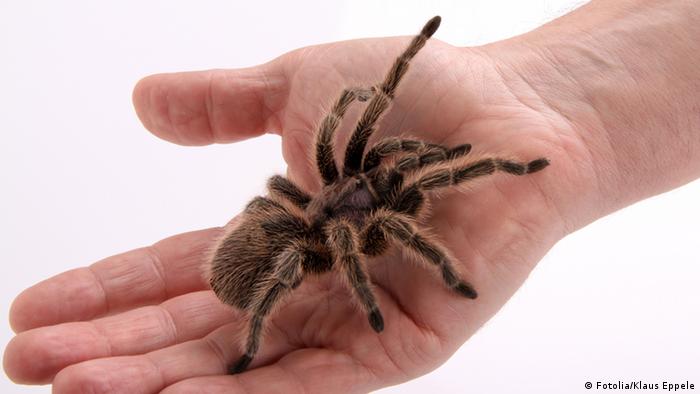Thursday, January 29, 2015 6:27:23 AM
Author Ian Johnson Date 28.01.2015
Click For Link
Liquified spider silk extruded in a gel via a three-dimensional printer could soon be regenerating damaged human heart muscle and nerve cells, according to German researchers.

Biomaterial experts at Germany's Bayreuth and Würzburg universities claimed a breakthrough in cultivating living cells while holding them in place with liquified spider silk.
The research method mixed spider silk with connective fibroblast cells from mice to generate a so-called "bio ink" or gel. Fibroblasts typically begin wound repairs.
When extruded from a 3-D printer, the silk molecules quickly wrapped those cells, giving them a porous matrix in which to flourish, the team said.
'New possibilities' for regenerative medicine?
Lead researchers, Bayreuth's professor Thomas Scheibel and Würzburg's professor Jürgen Groll said the method opened "completely new possibilities" for the regeneration of heart muscles as well as skin and nerve tissues.
During the development of a new bio ink based on spider silk the research team in Bayreuth and Würzburg achieved a "decisive breakthrough," they told the Pressetext news agency.
The gel flowed through the 3-D device's print head onto an extrusion surface, changing rapidly from its fluid into a firm state.

Could spider silk lead to enhanced cell repair?
It was a mechanism that spiders used to make their own fibers, said the researchers, referring to protein-rich spider web known for its lightweight strength and elasticity.
New forms of bio ink sought
Groll said the new research branch of "biofabrication" was urgently looking for new forms of bio inks with varying characteristics to create functional tissues.
The new 3-D silk ink print process opened a "promising" new field of research which could flow into a future Bavarian biopolymer institute, said Groll and Scheibel.
Funding for the project came from the DFG German Research Foundation, the EU and Germany's southern state of Bavaria.
Long-held hopes
From the early 19th century, cultivation of large spiders to extract their natural fiber was attempted in Europe but without great success.
In 2009, Science magazine carried a report that researchers at Germany's Max Planck Institute for Micro Structural Physics in Halle tripled the carrying strength of spider silk by drenching it with trace metals such as zinc, titanium or aluminum.
ipj/sms (pressetext, SID)
TRUTH
I've never claimed to have all the answers but feel i'm beginning to corner the market in questions worthy of solutions.
Recent KBLB News
- Form 424B3 - Prospectus [Rule 424(b)(3)] • Edgar (US Regulatory) • 08/16/2024 09:00:29 PM
- Form 10-Q - Quarterly report [Sections 13 or 15(d)] • Edgar (US Regulatory) • 08/14/2024 08:30:52 PM
- Form 424B3 - Prospectus [Rule 424(b)(3)] • Edgar (US Regulatory) • 06/10/2024 08:30:30 PM
- Form EFFECT - Notice of Effectiveness • Edgar (US Regulatory) • 06/04/2024 04:15:03 AM
- Form S-1/A - General form for registration of securities under the Securities Act of 1933: [Amend] • Edgar (US Regulatory) • 11/22/2023 09:31:54 PM
- Form 424B3 - Prospectus [Rule 424(b)(3)] • Edgar (US Regulatory) • 11/16/2023 09:30:34 PM
- Form 10-Q - Quarterly report [Sections 13 or 15(d)] • Edgar (US Regulatory) • 11/13/2023 09:43:51 PM
North Bay Resources Commences Operations at Bishop Gold Mill, Inyo County, California; Engages Sabean Group Management Consulting • NBRI • Sep 25, 2024 9:15 AM
CEO David B. Dorwart Anticipates a Bright Future at Good Gaming Inc. Through His Most Recent Shareholder Update • GMER • Sep 25, 2024 8:30 AM
Cannabix Technologies and Omega Laboratories Inc. Advance Marijuana Breathalyzer Technology - Dr. Bruce Goldberger to Present at Society of Forensic Toxicologists Conference • BLOZF • Sep 24, 2024 8:50 AM
Integrated Ventures, Inc Announces Strategic Partnership For GLP-1 (Semaglutide) Procurement Through MedWell USA, LLC. • INTV • Sep 24, 2024 8:45 AM
Avant Technologies Accelerates Creation of AI-Powered Platform to Revolutionize Patient Care • AVAI • Sep 24, 2024 8:00 AM
VHAI - Vocodia Partners with Leading Political Super PACs to Revolutionize Fundraising Efforts • VHAI • Sep 19, 2024 11:48 AM






